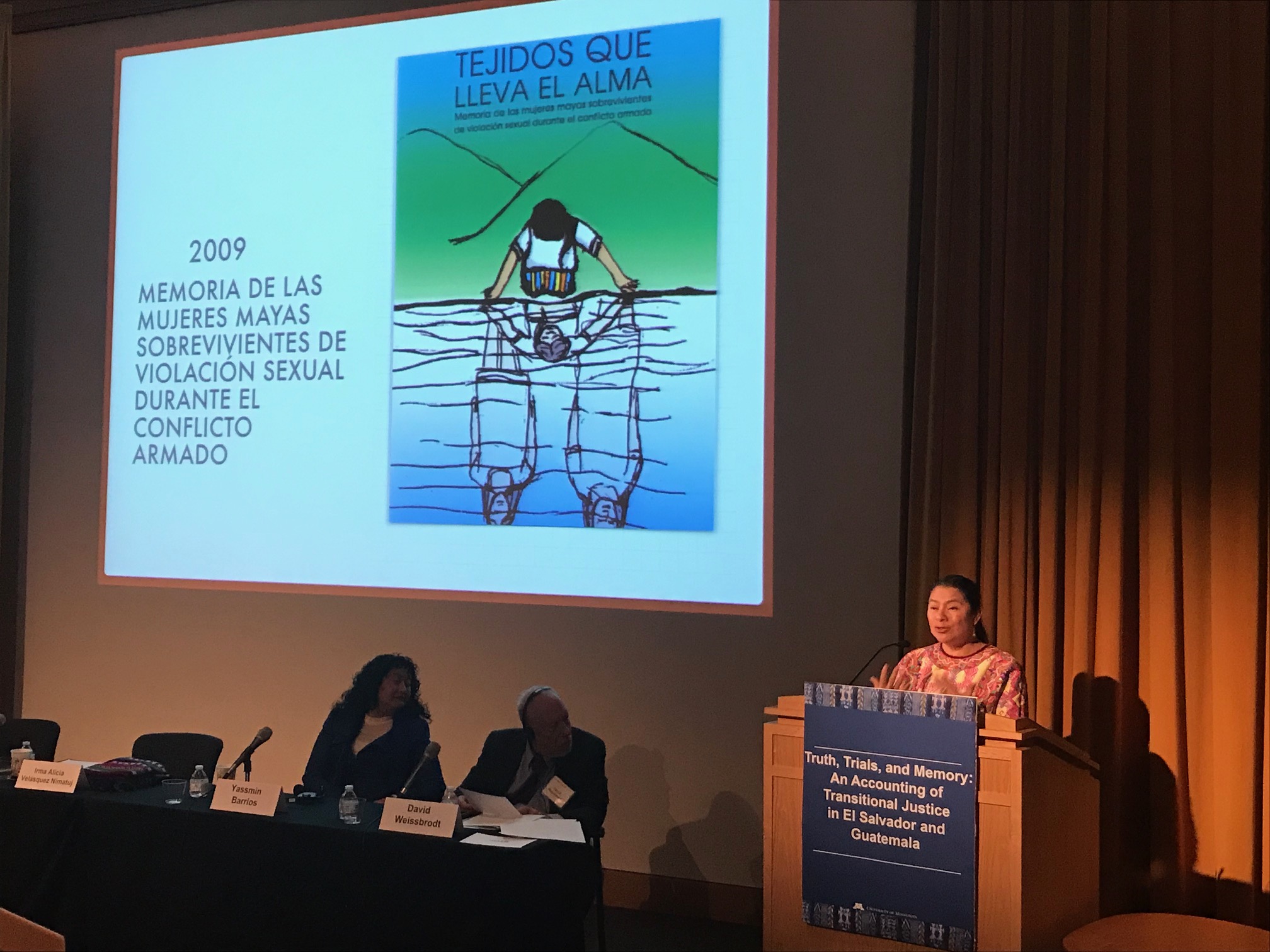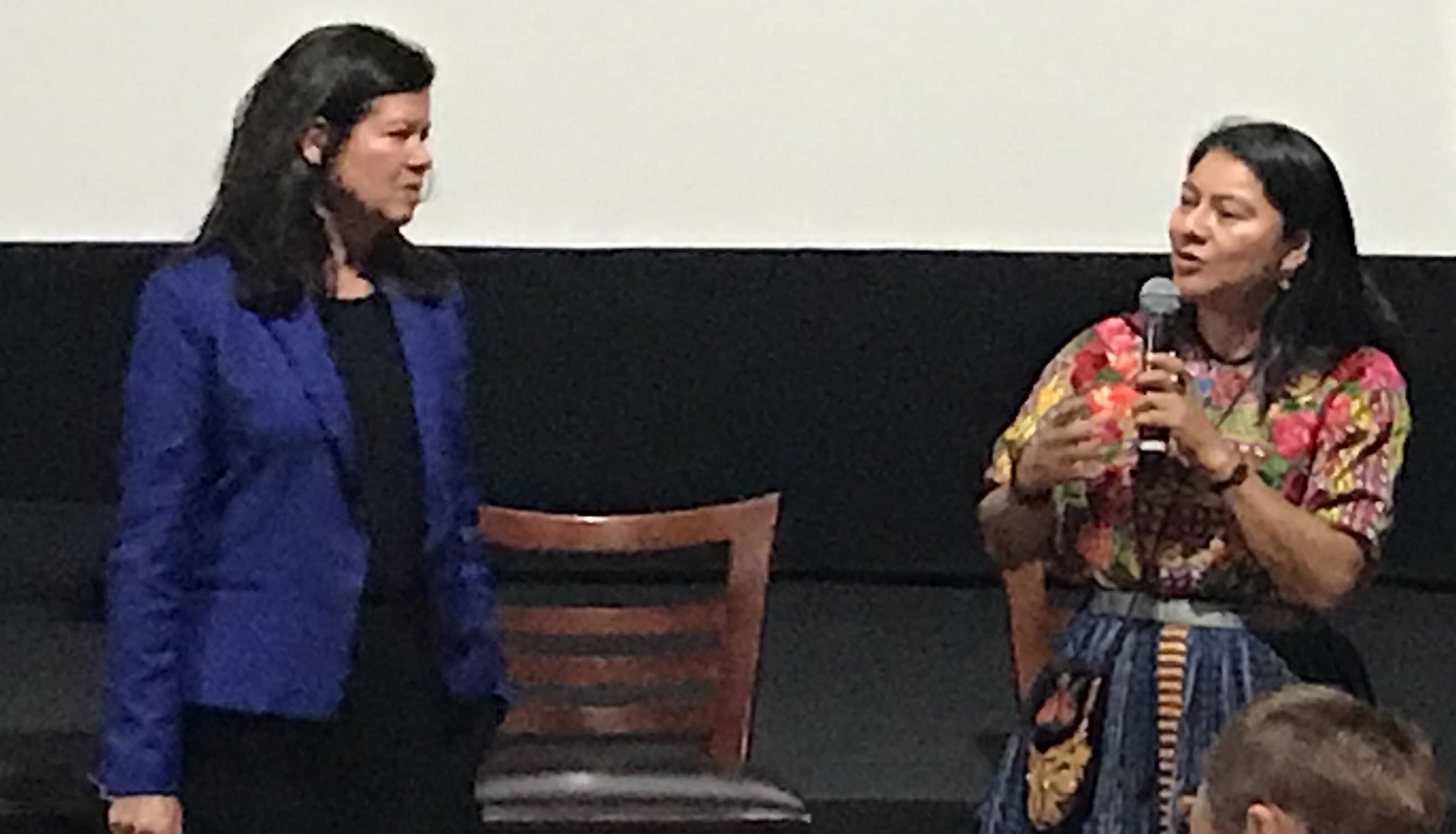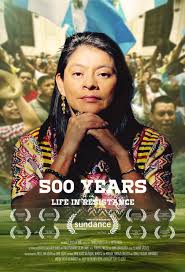The “Truth, Trials, Memory” conference, held at the University of Minnesota between November 1 – 3 opened with an ambitious quest: twenty years after the historical clarification commission in Guatemala, what does accountability look like? Further, in a time of increased civil discontent, protest, and resistance sweeping the United States, what can we learn from transitional justice and indigenous Guatemalan liberation projects?
Keynote speaker Pablo de Grieff opened the conference by naming four key components to transitional justice work done in post-conflict contexts: establishing truth, activating instruments of justice, the dispersal of services and reparations to victims, and the guarantee of non-recurrence. Yet, as the conference rolled onward, it became clearer and clearer to panelists and audience participants the grave difficulties and consequences of such achievements.

Indigenous K’ichee’ anthropologist, activist, author, and journalist – as well as the main protagonist of Pamela Yates’ newest film 500 Years – Irma Alicia Velásquez Nimatuj concluded her presentation with a powerful response to transitional justice researchers and practitioners. After describing the story of a woman who had to flee her own community during the conflict with her husband and four children, only to return alone after the conflict ended, Velásquez Nimatuj declares (orig. Spanish):
“All of this makes me question the methods of social sciences, all of this makes me question the work we do as anthropologists, that we do as social scientists – when we work well in our fields, for economic or academic rewards, but do not work to construct a new world. I deeply believe when I work in these cases that nothing will suffice as reparation. Nothing, for women, for girls, will repair them. Yet here I take it as a fundamental component of transitional justice. Careful revision is part of reparations.”
Earlier the previous evening, as Day of the Dead celebrations wrapped up across North and Central America, roughly a cinema house full of conference goers, twin cities community members, U of M students, and humanitarian scholars would shuffle across the Mississippi River into the historic St. Anthony Main Theatre to view a premier screening of 500 days by director and artist Pamela Yates who works closely with Irma Alicia.

The film is the third in Guatemala’s human rights #ResistanceSaga trilogy, a series of documentaries by Yates and her subject-affiliates about the thirty-six year armed conflict (1960-1996) and subsequent genocide of indigenous Maya by Guatemalan military, paramilitary, and national police personnel between 1982-83.
The genocide left nearly 150,000 Indigenous Maya murdered and 45,000 artists, community leaders, and activists disappeared. Years after initial clarification reports were released, Maya women survivors came forward with testimonial accounts of mass sexual violence and sexualized torture tactics of state forces during the conflict. In 2005, the discovery of a secret National Police archive in a defunct warehouse in downtown Guatemala City corroborated more than 7,000 Maya testimonies with upwards of 80 million recovered official government documents, including 2 million identity cards of persons registered as disappeared during the war.
When The Mountains Tremble (1983) and Granito: How to Nail a Dictator (2011), the first two films in the trilogy, document and analyze the deepening of existing social and political cleavages, inequalities, and oppressions during the conflict as well as recent tribunal efforts toward state accountability by survivors and justice practitioners, respectively. 500 years builds innovatively on the previous two films, however, insofar as it contextualizes violence against Maya groups within a more expansive Spanish colonial context.
For Indigenous Maya, resistance is both a political act and condition of political life in Guatemala. On the one hand, the years 1982-83 are known as “La Violencia,” the violence, by Guatemalan historians and historians of Guatemala. But indigenous Maya in their articulations of justice and sovereignty recount violences upon their lands, bodies, and cultures as far back as the early European colonial period, with violence peaking especially during trends of Guatemalan nation-state building, institutional and infrastructural development, resource extraction, and territorial expansion – all of which relied on and still enact colonialist mechanisms like forced evictions and displacements, property seizures, resource blockades, and subsequent criminalization and state neglect of evicted groups over the course of 500 years. Recent evictions of and protests by indigenous communities in Izabal and Alta Verapaz are one of countless examples of the technologies of the ‘post-colonial’ Guatemalan state to continue to repress the political life and significance of indigenous communities.
But indigenous political resistance in Guatemala has also been adapting to state violence to become more visible, organized, and effective. As 500 years depicts, mass protests, marches, demonstrations and community education efforts via radio, mobile cellular communications, social media and indigenous news broadcasting and presses are on the rise now more than ever.
As Irma Alicia so eloquently argues, the significance of indigenous women’s cultural production lies not just in the clarification and revision of historical memory, but in indigenous women sharing their stories and articulating justice “en sus propias voces,” in their own voices, “para construir sus propias cosmovisiones” to construct their own worldviews.
One of the most crucial takeaways thus from this conference is that auto-ethnography, personal narrative, testimonies, art practices and solidarity within and across borders, in official and unofficial capacities, are necessary parts of reparation. That there is power in speaking for oneself and one’s community. That there is power in sharing and defending one’s truths. Finally, that social scientists and anthropologists alike must work not just to understand the past and to learn about our world as it is today, but to transform it – to construct new worlds in our wake.
 500 Years concludes with a fitting scene of young Maya girls honoring the dead on All Saints Day, when giant colorful kites are weaved and flown to celebrate ancestors across the skies of Guatemala. The beauty and power of the metaphor speaks for itself, as the girls attempt twice unsuccessfully before their kite ultimately soars – seeming effortlessly, forever majestically – in playful circles that tease the sun.
500 Years concludes with a fitting scene of young Maya girls honoring the dead on All Saints Day, when giant colorful kites are weaved and flown to celebrate ancestors across the skies of Guatemala. The beauty and power of the metaphor speaks for itself, as the girls attempt twice unsuccessfully before their kite ultimately soars – seeming effortlessly, forever majestically – in playful circles that tease the sun.
500 Years is now available for streaming on Amazon Prime. A national television broadcast will air throughout the United States via PBS on January 1, 2018. When The Mountains Tremble (1983) and Granito: How to Nail a Dictator (2011), the first two films in the trilogy, are currently streaming for free on YouTube.
Hale Konitshek is a PhD candidate in Feminist Studies whose dissertation pieces together an ethnography of informal women’s institutions for sexual assault and gender violence protocol throughout Guatemala. Hale also works as a sexual violence counselor and advocate with SOS Sexual Violence Services of Ramsey County, Minnesota.

Comments